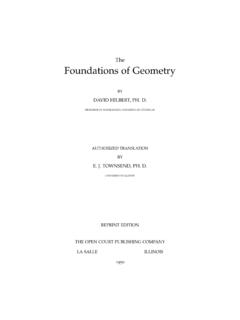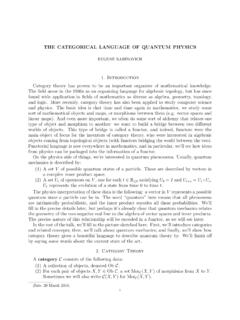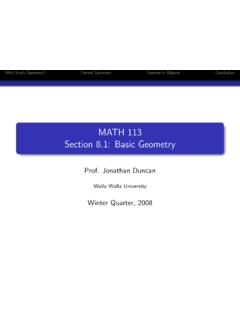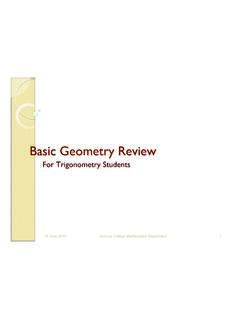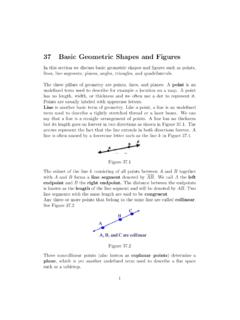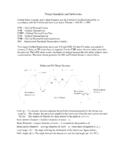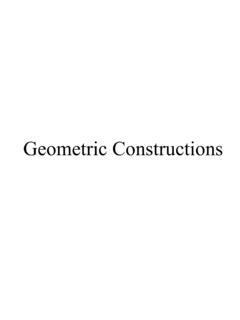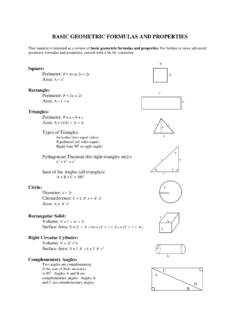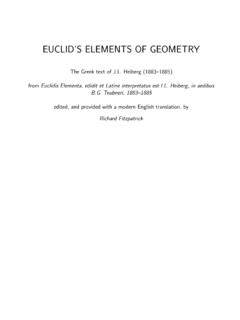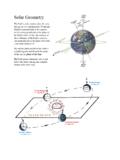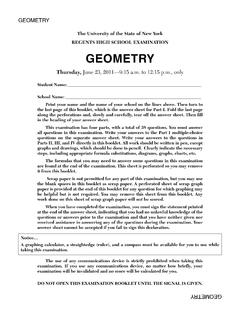Transcription of Teaching Geometry in Grade 8 and High School …
1 Teaching Geometry in Grade 8 andHigh School According to theCommon Core StandardsH. Wuc Hung-Hsi Wu 2013 October 16, 2013 ContentsGrade 861. Basic rigid motions and congruence (page 8)2. Dilation and similarity (page 42)3. The angle-angle criterion (AA) for similarity (page 57)4. The Pythagorean Theorem (page 61)5. The angle sum of a triangle (page 66)6. Volume formulas (page 68)High School731. Basic assumptions and definitions (page 80)2. Definitions of basic rigid motions and assumptions (page 95)3. Congruence criteria for triangles (page 110)14. Some typical theorems (page 126)5. Constructions with ruler and compass (page 144)6.
2 Definitions of dilations and similarity (page 149)7. Some theorems on circles (page 175)2 PrefaceThis is the companion article to Teaching Geometry According to the CommonCore Common Core State Standards for Mathematics (CCSSM) have reorganizedthe Geometry curriculum in Grade 8 and high School . Because there are at presentvery few (if any) ready references for such a reorganization, this document is beingoffered as a stopgap terms of the topics covered, there is hardly any difference between what iscalled for by the CCSSM and by the other curricula. The change occurs mainly inthe internal (mathematical) reorganization and the change of (mathematical) example, transformations are usually taught as rote skills in middle School with nomathematical applications or relevance, and the concepts of congruence and similarityaretalked aboutbut never defined except in the case of polygons.
3 By contrast, theCCSSM develop all these topics on the foundation of transformations, thereby givingthem coherence and purposefulness. The coherence of the CCSSM has been muchbandied about in recent discussions, but it is time to realize that the coherence ofthe CCSSM is not an educational slogan but amathematicalfact, and one of itsmanifestations is the coherence of the Geometry curriculum embedded in the the benefit of students learning, this change is a welcome development. However,it is unfortunately the case that while these basic topics are routinely discussed in themathematics literature, not much of this information can be found in the educationliterature except perhaps H.
4 Wu, Pre-Algebra. The intentions of the CCSSM havethus become hidden for the time being. If the detailed account given in this documentis at all successful, it will furnish a bridge across this mathematical chasm for thetime specific targets are middle and high School mathematics teachers as well asthe publishers of textbooks. I hope that teachers will find this account helpful in theirpreparations for the implementation of CCSSM by year 2014. If, in addition, theirschool district can offer professional development, then maybe they can make use ofthis document to articulate the kind of professional development they want.
5 We areentering an era when teachers must take an active role in their own professional CCSSM are charting a new course, and district administrators and professionaldevelopers have to work together with teachers to find their new bearings in the3transitional for the publishers, my contact with them in the past fifteen years has made meaware that their claim of not having the needed resources to improve their books is in-deed entirely legitimate. Our educational system has been broken for a long time andwe have to find ways to forge a new beginning. At a time when the CCSSM are initi-ating a significant change in the Teaching of Geometry , it would be unconscionable asin the days of the New Math to once again ask for change without providing thenecessary support for this change.
6 It is hoped that this document will provide sometemporary relief in the present absence of this document is essentially a compendium of selected topics from the lecturenotes for the annual summer professional development institutes (MPDI) and upperdivision courses (Math 151 153) at Berkeley that I have given since 2006. I have beenadvocating this transformations-based approach to the Teaching of middle School andhigh School Geometry because, in terms of student learning, it is a more reasonablealternative to the existing ones (see the discussions on page 79 ff. and page 125 ff. forpart of the reason). By a happy coincidence, the CCSSM agreed with this judgment.
7 (The reference,Wu, H., Lecture Notes for the 2009 Pre-Algebra Institute, September15, 2009. on page 92 of the CCSSM is the same as H. Wu, Pre-Algebra.) In any case,the detailed development of this approach to middle School and high School Geometry ,together with exercises, will be found in the following textbooks by the author:FromPre-Algebra to Algebra(for middle School teachers, to appear in late 2014), andMathematics of the Secondary School Curriculum(a two volume set for highschool teachers, to appear probably in late 2015).It may also be mentioned that I expect to post detailedstudentlessons for grade8 according to the CCSSM by the fall of wish to thank Wolfgang Buettner for his interesting con-tributions, Mark Saul for his willingness to read through the Grade 8 portion andmake suggestions, and Larry Francis for his usual excellent editorial assistance.
8 ToAngelo Segalla and Clinton Rempel, I owe an immense debt for numerous turquoise box around a phrase or a sentence (such as H. Wu, Pre-Algebra)indicates an active link to an article standards on Geometry are listed at the beginning of each Grade insans congruence and similarity using physical models, transparencies,or Geometry Verify experimentally the properties of rotations, reflections, and translations:a. Lines are taken to lines, and line segments to line segments of the same Angles are taken to angles of the same Parallel lines are taken to parallel Understand that a two-dimensional figure is congruent to another if the second canbe obtained from the first by a sequence of rotations, reflections, and translations.
9 Giventwo congruent figures, describe a sequence that exhibits the congruence between Describe the effect of dilations, translations, rotations, and reflections on two-dimensional figures using Understand that a two-dimensional figure is similar to another if the second can beobtained from the first by a sequence of rotations, reflections, translations, and dilations;given two similar two-dimensional figures, describe a sequence that exhibits the similaritybetween Use informal arguments to establish facts about the angle sum and exterior angleof triangles, about the angles created when parallel lines are cut by a transversal, and theangle-angle criterion for similarity of triangles.
10 For example, arrange three copies of thesame triangle so that the sum of the three angles appears to form a line, and give anargument in terms of transversals why this is and apply the Pythagorean Explain a proof of the Pythagorean Theorem and its Apply the Pythagorean Theorem to determine unknown side lengths in right trian-gles in real-world and mathematical problems in two and three Apply the Pythagorean Theorem to find the distance between two points in a coor-dinate system. Solve real-world and mathematical problems involving volume of cylinders,cones, and Know the formulas for the volumes of cones, cylinders, and spheres and use themto solve real-world and mathematical of eighth Grade geometry1.
